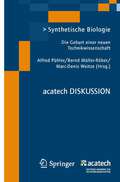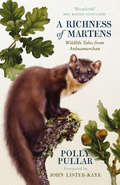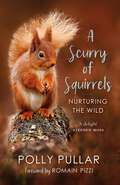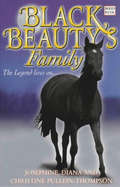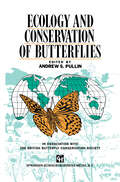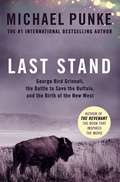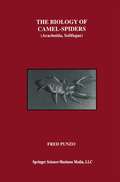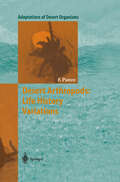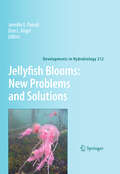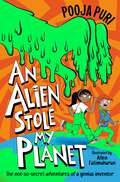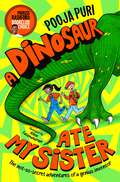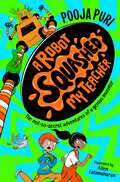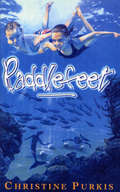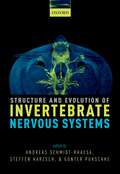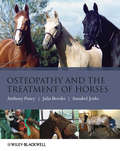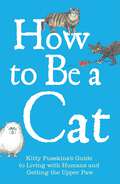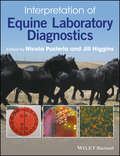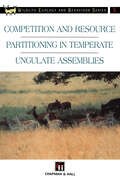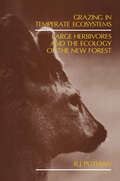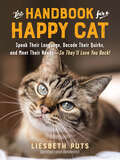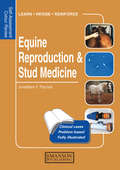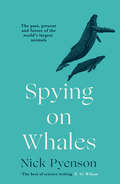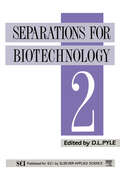- Table View
- List View
Synthetische Biologie: Die Geburt einer neuen Technikwissenschaft (acatech DISKUTIERT)
by Alfred Pühler Bernd Müller-Röber Marc-Denis WeitzeEine wirtschaftliche und einfache Herstellung komplexer Moleküle für maßgeschneiderte Werkstoffe, Arzneimittel oder auch Treibstoffe, dazu neue Methoden für Forschungszweige wie Biomedizin, Materialwissenschaft oder Katalyseforschung: Die Liste potenzieller Anwendungen der Synthetischen Biologie, einer Forschungsrichtung zwischen Molekularbiologie, Organischer Chemie, Nanobiotechnologie und Informationstechnik, ist lang. Ausgehend von der bereits großen Bedeutung der Biotechnologie in der chemischen Industrie könnte es in den nächsten Jahren zu einer regelrechten Biologisierung der Wirtschaft kommen. Die neue Technikwissenschaft an der Grenze von Biologie und Technik übt eine große Faszination aus, die dieser Band weitergeben möchte - freilich ohne die Herausforderungen auszublenden.
A Richness of Martens: Wildlife Tales from Ardnamurchan
by Polly PullarWhen Les and Chris Humphreys moved to Ardnamurchan 15 years ago, little did they realise they would be sharing their home with some of Britain’s most elusive and misunderstood mustelids. Amongst all the animals and birds that visit their garden, they have formed a special bond with numerous pine martens, and have studied them and a cast of other creatures at close range through direct observation and via sensor-operated cameras.Naturalist and photographer Polly Pullar has known the Humphreys and their pine martens for many years. In this book she tells the remarkable story of the couple and their animal friends, interpolating it with natural history, anecdote and her own experiences of the wildlife of the area. The result is a fascinating glimpse into the life of a much misunderstood animal and a passionate portrait of one of Scotland’s richest habitats – the oakwoods of Scotland’s Atlantic seaboard.
A Scurry of Squirrels: Nurturing The Wild
by Polly PullarPolly Pullar has had a passion for red squirrels since childhood. As a wildlife rehabilitator, she knows the squirrel on a profoundly personal level and has hand-reared numerous litters of orphan kits, eventually returning them to the wild.In this book she shares her experiences and love for the squirrel and explores how our perceptions have changed. Heavily persecuted until the 1960s, it has since become one of the nation’s most adored mammals. But we are now racing against time to ensure its long-term survival in an ever-changing world.Set against the beautiful backdrop of Polly’s Perthshire farm, where she works continuously to encourage wildlife great and small, she highlights how nature can, and indeed will, recover if only we give it a chance. In just two decades, her efforts have brought spectacular results, and numerous squirrels and other animals visit her wild farm every day.
Black Beauty's Family
by Josephine Pullein-Thompson Diana Pullein-Thompson Christine Pullein ThompsonEveryone's heard about Black Beauty, probably the greatest horse that ever lived. But what about the rest of his family? Here we meet some of his other extraordinary relations, each with an amazing story to tell. There's his brother, Black Ebony, who is involved in a terrible mining accident; his great niece, Black Princess, a heroine in World War One; and then there's Black Velvet, a distant relation whose life as a show jumper is about to change dramatically.
Ecology and Conservation of Butterflies
by Andrew S. PullinThis book was conceived to mark the Silver Jubilee of the British Butterfly Conservation Society. Interest in the conservation of butterflies has increased so rapidly that it is difficult to relate to the situation 25 years ago. Butterflies were on the decline in Britain, Europe and elsewhere but we lacked data on the extent of the decline and the underlying reasons, leaving us unable to implement effective conservation measures. An early recognition of the plight of British butterflies and moths led to the foundation of the society by a small group of conservationists in 1968. Today the society has over 10000 members, owns a number of reserves and sponsors research, conservation and monitoring activities at the local and national level. As part of the Silver Jubilee celebrations an international symposium was held at Keele University in September 1993 entitled 'Ecology and Conservation of Butterflies'. This symposium clearly showed how much important work has been done in recent years and also gave me the impression that the subject had reached a watershed. This was not because the decline of butterflies has stopped or even slowed down, far from it, the threat to our butterflies continues to increase from habitat destruction and intensification of land use. The watershed is in our understanding of the relationship between butterflies and their habitat.
Last Stand: George Bird Grinnell, The Battle To Save The Buffalo, And The Birth Of The New West
by Michael PunkeFrom the #1 international bestselling author of THE REVENANT – the book that inspired the award-winning movie – comes the fascinating story of America’s first battle over the environment.
The Biology of Camel-Spiders: Arachnida, Solifugae
by Fred PunzoMy initial interest in the Solifugae (camel-spiders) stems from an incident that occurred in the summer of 1986. I was studying the behavioral ecology of spider wasps of the genus Pepsis and their interactions with their large theraphosid (tarantula) spider hosts, in the Chihuahuan Desert near Big Bend National Park, Texas. I was monitoring a particular tarantula burrow one night when I noticed the resident female crawl up into the burrow entrance. Hoping to take some photographs of prey capture, I placed a cricket near the entrance and waited for the spider to pounce. Suddenly, out of the comer of my eye appeared a large, rapidly moving yellowish form which siezed the cricket and quickly ran off with it until it disappeared beneath a nearby mesquite bush. So suddenly and quickly had the sequence of events occurred, that I found myself momentarily startled. With the aid of a headlamp I soon located the intruder, a solifuge, who was already busy at work macerating the insect with its large chelicerae (jaws). When I attempted to nudge it with the edge of my forceps, it quickly moved to another location beneath the bush. When I repeated this maneuver, the solifuge dropped the cricket and lunged at the forceps, gripping them tightly in its jaws, refusing to release them until they were forcefully pulled away.
Desert Arthropods: Life History Variations (Adaptations of Desert Organisms)
by Fred PunzoIt is difficult for me to recollect a time when I was not fascinated with the very notion of a desert. Walt Disney's film, The Living Desert, which I initially saw when I was 8 years of age, provided me with my first glimpse of this wondrous yet seemingly ho stile environment. The images were hypnotic and captivating. I looked on in amazement at the promenade Cl deux of the male and female scorpions during courtship. Their rhythmic and coordinated movements as they grasped one another made them appear to glide in unis on over the surface of the sand, each individual totally absorbed with its partner. In the next minute the fern ale had suddenly and utterly transformed herself like some Jekyll and Hyde act, into an aggressive predator whose prior gregarious embrace was now a hold of death for the male. The indomitable desert grasshopper mouse, the ever sentient kit fox, the graceful shovel-nosed snake swimming in an endless sea of sand.
Jellyfish Blooms: New Problems and Solutions (Developments in Hydrobiology #212)
by Jennifer E. Purcell Dror L. AngelAn Alien Stole My Planet
by Pooja PuriAn Alien Stole My Planet is a laugh-out-loud, wacky adventure through space by Pooja Puri, brilliantly illustrated by Allen Fatimaharan. It is the third book in the A Dinosaur Ate My Sister series.Before you start reading, there are a few things you should know:1. I, Esha Verma, am a genius inventor extraordinaire.2. I like lists.3. I did not mean to open up an inter-galactic portal. Some things just can't be helped.Esha Verma, her snotty apprentice Broccoli and his secretly cunning pet tortoise are on their third adventure – this time it's an inter-galactic mission through outer-space to stop an alien from stealing their planet!When Esha invents the Inviz-Whiz, a device designed to make the user invisible, she does not expect it to open a portal to outer space – and things go from bad to worse when Esha, Broccoli, Archibald and Broccoli's annoying cousin Bean are immediately abducted by Goospa, an alien with an evil plan!With the help of a surly alien called Nix, Esha and the gang must race across the galaxy, navigate a Lava Marsh, fight vicious Ice Bats – and stop Bean getting into too much trouble! – to stop Goospa's plan before it's too late!
A Dinosaur Ate My Sister: A Marcus Rashford Bookclub Choice (A Dinosaur Ate My Sister)
by Pooja PuriA Dinosaur Ate My Sister is the first book selected in the Marcus Rashford Book Club.'The perfect story to escape into and find adventure. Pooja is super talented and I'm a big fan!' - Marcus Rashford MBEThis brilliantly illustrated, laugh-out-loud, wacky adventure through time by Pooja Puri is the perfect blend of The Hitchhiker's Guide to the Galaxy and Jurassic Park. Before you start reading, there are a few things you should know:1. I, Esha Verma, am a genius inventor extraordinaire.2. There is nothing I cannot invent. This includes words. 3. I did not mean to send my sister back to the Age of the Dinosaurs. That was HER OWN FAULT (Mum and Dad, if you’re reading this, please take note).Esha Verma, her snotty apprentice Broccoli and his cunning pet tortoise have a dream. They are going to win the legendary Brain Trophy – the ultimate inventing prize. This year's entry: A TIME MACHINE.But the day before the competition, Esha's IGNORAMUS big sister hijacks the time machine and is lost in the Cretaceous age. With help from a new recruit for The Office of Time, Esha and Broccoli will have to face hungry dinosaurs, mysterious black holes and malfunctioning inventions to get them back in time.The Marcus Rashford Book Club is a collaboration between Marcus Rashford and Macmillan Children's Books, inspiring children to develop a love of reading and literacy as a life skill.
A Robot Squashed My Teacher (A Dinosaur Ate My Sister)
by Pooja PuriA Robot Squashed My Teacher is the laugh-out-loud, wacky adventure by Pooja Puri brilliantly illustrated by Allen Fatiaharan, the sequel to the Marcus Rashford Bookclub Selected book A Dinosaur Ate My Sister. Before you start reading, there are a few things you should know:1. I, Esha Verma, am a genius inventor extraordinaire.2. I like lists.3. I did not mean to turn my teacher into a pigeon. Some things just can't be helped.Esha Verma, her snotty apprentice Broccoli and his secretly cunning pet tortoise have a dream. They are going to win the legendary Brain Trophy – the ultimate inventing prize. This year's entry: The RoarEasy – a gadget that lets the user speak to animals.But when Esha's arch-nemesis, fellow inventor Ernie, lands her in detention, the RoarEasy malfunctions and suddenly Monsieur Crépeau is TRANSFORMED INTO A PIGEON.Luckily for Esha, she knows exactly what she needs to repair her invention and where to find it: locked away in the mysterious Central Research Laboratories. She, Broccoli, Archibald and Monsieur Crépeau will have to go undercover and break into the labs before the competition to return Monsieur Crépeau to his human form. And with Ernie following them, determined to foil their plans as they face giant robots, killer plants, shrinking machines, robo-spiders, clouds that make you float and terrifying twisters, they're going to need all the help they can get to get out of this wacky pickle.
Paddlefeet
by Christine PurkisDarting through the water, the tiny creature feels a vast shadow and sees gigantic thrashing limbs: a Paddlefoot! Peering into the depths from up above, the girl glimpses a flash of blue and a sequinned tail. Surely she must be dreaming? Little does Jo know what she has spotted one of the Waterfolk who have made their home behind the waterfall. Soon the destinies of Paddlefeet and Waterfolk are entwined as Jo and her friends, Fizz and Tash, battle to save the vulnerable river-dwellers before it' s too late, in the most exciting adventure of their lives.
Structure and Evolution of Invertebrate Nervous Systems
by Günter Purschke Andreas Schmidt-Rhaesa Steffen HarzschThe nervous system is particularly fascinating for many biologists because it controls animal characteristics such as movement, behavior, and coordinated thinking. Invertebrate neurobiology has traditionally been studied in specific model organisms, whilst knowledge of the broad diversity of nervous system architecture and its evolution among metazoan animals has received less attention. This is the first major reference work in the field for 50 years, bringing together many leading evolutionary neurobiologists to review the most recent research on the structure of invertebrate nervous systems and provide a comprehensive and authoritative overview for a new generation of researchers. Presented in full colour throughout, Structure and Evolution of Invertebrate Nervous Systems synthesizes and illustrates the numerous new findings that have been made possible with light and electron microscopy. These include the recent introduction of new molecular and optical techniques such as immunohistochemical staining of neuron-specific antigens and fluorescence in-situ-hybridization, combined with visualization by confocal laser scanning microscopy. New approaches to analysing the structure of the nervous system are also included such as micro-computational tomography, cryo-soft X-ray tomography, and various 3-D visualization techniques. The book follows a systematic and phylogenetic structure, covering a broad range of taxa, interspersed with chapters focusing on selected topics in nervous system functioning which are presented as research highlights and perspectives. This comprehensive reference work will be an essential companion for graduate students and researchers alike in the fields of metazoan neurobiology, morphology, zoology, phylogeny and evolution.
Osteopathy and the Treatment of Horses
by Anthony Pusey Julia Brooks Annabel JenksWritten by pioneering and internationally-renowned specialists in the field, this text provides clinically-orientated information on osteopathy as a treatment for horses. It explains the scientific rationale of how osteopathy works in animals, as well as providing a detailed working guide to the technical skills and procedures you need to know to perform safe and effective osteopathic procedures. Drawing on well established practices for humans this book provides details on the full variety of diagnostic and therapeutic osteopathic procedures that can be used on horses. Full of practical information, it demonstrates how professionals treating equine locomotor problems can adapt different procedures in different clinical settings. Over 350 colour images and detailed step-by-step instructions demonstrate the procedures and practice of osteopathy. Covers treatment both with and without sedation and general anaesthetic. This comprehensive text is written for students and practitioners of osteopathy with an interest in treating horses. It will also be useful to other allied therapists, and to veterinary practitioners who want to know more about the treatment of musculoskeletal problems.
Osteopathy and the Treatment of Horses
by Anthony Pusey Julia Brooks Annabel JenksWritten by pioneering and internationally-renowned specialists in the field, this text provides clinically-orientated information on osteopathy as a treatment for horses. It explains the scientific rationale of how osteopathy works in animals, as well as providing a detailed working guide to the technical skills and procedures you need to know to perform safe and effective osteopathic procedures. Drawing on well established practices for humans this book provides details on the full variety of diagnostic and therapeutic osteopathic procedures that can be used on horses. Full of practical information, it demonstrates how professionals treating equine locomotor problems can adapt different procedures in different clinical settings. Over 350 colour images and detailed step-by-step instructions demonstrate the procedures and practice of osteopathy. Covers treatment both with and without sedation and general anaesthetic. This comprehensive text is written for students and practitioners of osteopathy with an interest in treating horses. It will also be useful to other allied therapists, and to veterinary practitioners who want to know more about the treatment of musculoskeletal problems.
How to Be a Cat: Kitty Pusskin's Guide to Living with Humans and Getting the Upper Paw
by Kitty Pusskin Mark LeighWritten by a cat, and with helpful insights by other cats, How to Be a Cat is essential reading not just for all felines but also for their owners and cat lovers alike … if only to get an insight into their pet’s sometimes curious behaviour.As you'd expect from a book written by a cat about humans, the advice can be condescending, cynical and anarchic in equal measures. Kitty Pusskin and her cat companions offer helpful observations and advice on specific feline issues, such as the best kind of furniture on which to sharpen your claws, how to wake up owners who don’t supply breakfast on time, and why you should never leave an empty box unexplored.How to Be a Cat is the official rulebook of the feline world, a hilarious and useful guide for living with – or putting up with – humans, and always getting the upper paw.
Interpretation of Equine Laboratory Diagnostics
by Nicola Pusterla Jill HigginsInterpretation of Equine Laboratory Diagnostics offers a comprehensive approach to equine laboratory diagnostics, including hematology, clinical chemistry, serology, body fluid analysis, microbiology, clinical parasitology, endocrinology, immunology, and molecular diagnostics. Offers a practical resource for the accurate interpretation of laboratory results, with examples showing real-world applications Covers hematology, clinical chemistry, serology, body fluid analysis, microbiology, clinical parasitology, endocrinology, immunology, and molecular diagnostics Introduces the underlying principles of laboratory diagnostics Provides clinically oriented guidance on performing and interpreting laboratory tests Presents a complete reference to establish and new diagnostic procedures Offers a practical resource for the accurate interpretation of laboratory results, with examples showing real-world applications Covers hematology, clinical chemistry, serology, body fluid analysis, microbiology, clinical parasitology, endocrinology, immunology, and molecular diagnostics Introduces the underlying principles of laboratory diagnostics Provides clinically oriented guidance on performing and interpreting laboratory tests Presents a complete reference to established and new diagnostic procedures
Interpretation of Equine Laboratory Diagnostics
by Nicola Pusterla Jill HigginsInterpretation of Equine Laboratory Diagnostics offers a comprehensive approach to equine laboratory diagnostics, including hematology, clinical chemistry, serology, body fluid analysis, microbiology, clinical parasitology, endocrinology, immunology, and molecular diagnostics. Offers a practical resource for the accurate interpretation of laboratory results, with examples showing real-world applications Covers hematology, clinical chemistry, serology, body fluid analysis, microbiology, clinical parasitology, endocrinology, immunology, and molecular diagnostics Introduces the underlying principles of laboratory diagnostics Provides clinically oriented guidance on performing and interpreting laboratory tests Presents a complete reference to establish and new diagnostic procedures Offers a practical resource for the accurate interpretation of laboratory results, with examples showing real-world applications Covers hematology, clinical chemistry, serology, body fluid analysis, microbiology, clinical parasitology, endocrinology, immunology, and molecular diagnostics Introduces the underlying principles of laboratory diagnostics Provides clinically oriented guidance on performing and interpreting laboratory tests Presents a complete reference to established and new diagnostic procedures
Competition and Resource Partitioning in Temperate Ungulate Assemblies (Chapman & Hall Wildlife Ecology and Behaviour Series)
by R.J. PutmanRory Putman addresses the question of how, in many temporate ecosystems, diverse and species-rich assemblies of ungulates manage to co-exist despite often quite extensive overlap in ecological requirements. Putman explores the potential for competition, competition tolerance and even positive facilitation amongst the members of such guilds of ungulates. As a central worked example, the author employs data resulting from over 20 years of personal research into the ecology and population dynamics of various large herbivores of the New Forest in Southern England. With these, he applies formal protocols in resource use, evidence for resource limitation and evidence for interaction between species in changing population size over the years.
Grazing in Temperate Ecosystems: Large Herbivores and the Ecology of the New Forest
by R.J. PutmanThe New Forest in southern England is an area of mixed vegetation set aside as a Royal Hunting Forest in the eleventh century and since that time subjected to heavy grazing pressure from large herbivores. The entire structure of the Forest and its various communities has been developed under this continued history ofheavy grazing, with the estab lishment of a series of vegetational systems unique within the whole of Europe. The effects of large herbivores in the structuring of this eco system in the past, and the pressure of grazing continuing to this day, have in turn a profound influence, indeed the dominating influence, on the whole ecological functioning of the Forest system. Because of its assemblage of unique vegetation types, the area is clearly of tremendous ecological interest in its own right. In addition, its long history of heavy grazing ani the continued intense herbivore pressure make the New Forest an ideal study-site for evaluation of both short-term and long term effects of grazing upon temperate ecosystems. The N ew Forest (some 37,500 ha in total area) currently supports a population of approximately 2,500 wild deer (red, roe, sika and fallow); in addition 3,500 ponies and 2,000 domestic cattle are pastured on the Forest under Common Rights.
The Handbook for a Happy Cat: Speak Their Language, Decode Their Quirks, and Meet Their Needs—So They'll Love You Back!
by Liesbeth PutsGive your best friend more purr and pounce with this whiskers-to-tail guide to the good life! One reason we&’re wild for cats is that our cats are still wild at heart. On our laps, they&’re purring lovebugs, but on the prowl, they&’re fearsome hunters—with territorial instincts to match.The Handbook for a Happy Cat takes us inside the feline mind to decode what our cats really want in life and how they try to tell us. You&’ll learn:Why a bigger water bowl does away with &“whisker stress&”How to move like a mouse for maximum fun at playtimeSkills to teach your kitten for a lifetime of easy vet visits, grooming, and moreSubtle signs of stress such as excessive scent-marking and lip-lickingHow to tell frolic from fighting in the multi-cat household (and how to give frenemies a fresh start)What makes a scratching post so tempting that your sofa will be sparedHow to reassure a spooked cat with the &“slow blink&”Why it&’s pointless to &“punish&” a cat—but training is possible! Certified behaviorist Liesbeth Puts traces every feline mystery to cats&’ natural behavior and needs. A happy cat is a cat who can be herself!
Equine Reproduction & Stud Medicine: Self-Assessment Color Review
by Jonathan PycockInvolvement with equine reproduction is very common for the veterinarian in practice, and there is enormous demand for continuing education, particularly in the light of recent changes in science and practice, such as the routine use of ultrasound, improved standards of foal care, and the importance of artificial insemination.The 22 contributing au
Spying on Whales: The Past, Present, And Future Of Earth's Most Awesome Creatures
by Nick PyensonWhales are among the largest, most intelligent, deepest diving species to have ever lived on our planet. We have hunted them for thousands of years and scratched their icons into our mythologies. They simultaneously fill us with waves of terror, awe and affection – yet we know hardly anything about them.
Separations for Biotechnology 2
by D. Leo PyleThe challenge of bioseparations is to isolate and purify identified products from the dilute product broth produced from cell culture. Innovation in bioseparations technology is increasingly driven by the requirements imposed by the growing importance of production on a process scale of injectable-grade products, and economic pressures to improve the efficiency of downstream processing. As in other areas of technical change, science does not necessarily precede new technology: progress results from a complex and messy mixture of advances in understanding, ingenious ideas, novel techniques and chance discoveries. What is certain is that close interaction between academics and practitioners, biological scientists and process engineers is needed to solve the problems of bioseparations. The Second International Conference on Separations for Biotechnology at Reading, UK, in September 1990 set out to provide a critical multidisciplinary forum for the discussion of bioseparations. This volume contains the papers presented at the meeting. The meeting was organised around six themes with oral and poster presentations on the science and practice of bioseparations technology, and the same structure has been kept for this book. We have also included the texts of the keynote review paper by Professor Alan Michaels and the introductory review papers specially commissioned for the conference. Within each part of this book the review paper is followed by the contributed papers grouped alphabetically by their first author. All the original papers published here were accepted for publication after scientific refereeing.
